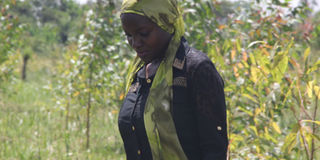Trees are a way of life that she earns from

Nagawa in the field when she has the younger trees. PHOTO BY ESERI WATSEMWA
Some people plant trees to earn a living, some do it to conserve the environment. For Aisha Nagawa, 28, it is a combination of these as she has made it a way of life.
“Trees are a part of me. I cannot depart from them”. This is how Nagawa greeted me on arrival at her farm in Kyanuna village, Wakiso District.
It was in 2010, as a third year student of forestry at Makerere University, that Nagawa started planting trees. It was initially a bobby, but when she failed to get a part-time job to fill the evening hours, she decided to invest in eucalyptus, aware that after school, she would reap from her efforts.
Unlike for livestock and some crops, Nagawa was certain trees did not require as much time and care, so she could have time to run other errands. “All I had to do was plant and let them grow. Besides, eucalyptus self-prunes,” she says, as she brushes beads of sweat off her veiled face.
“It was experimental tree planting around the compound and in the coffee and banana plantations. “My parents and siblings were fully involved. I ended up spending only Shs200, 000 for labour and termite control since the garden was already established,” she reveals.
The start
From her savings, she bought 210 eucalyptus clones (seedlings) at Shs500 each from a nursery in Seeta on advice from a colleague at National Forestry Resources Research Institute (NaFORRI) where she had interned.
At the time, clones were not popular but she knew they were the deal. Clones, according to Nagawa, are the best seedlings to plant.
“They are disease resistant, grow big in size and girth and are of superior quality making them ideal for timber. Besides, they grow quickly and can be site-matched; implying that one can buy specific clones for particular types of soils”.
In three years, one can get poles for building and from eight to 10 years, you can get timber.
The six-year-old boundary trees in her father’s compound have been functional. A number of them (10 to 20) are cut down and sold as poles at Shs4,000 each, and re-sprouted.
After university, she did not sit home waiting for a job after being disappointed on several occasions. “At one time I applied for a job online and realised the deadline was two months ago yet they were still calling for applications in the adverts. I was demotivated and decided to concentrate on tree planting,” she says.
Nagawa draws inspiration from her parents who have formal jobs but still make crafts such as mats, baskets and crocheting. Even when she had to juggle jobs between acting as a marketer in a bookshop and community forestry, she did not take her eyes off farming.
Last year, she decided to partner with a relative to venture into commercial tree planting. She got two and a half acres of land from her father, from the chunks of grazing land the family owns.
Basing on her wealth of knowledge in the field, she gathered 1,100 clones (796 and 796/2 Grandis Camaldulensis (GC)) from trusted sources. Each was Shs600. Eighty per cent of these survived.
She explains that GC clones are cheap, root easily and are favoured by cool conditions, contrary to the Grandis Urophylla (GU), which are more expensive and hard rooters but also insect resistors.
“We used about 1.7m to establish the forest and carry out activities such as buying chemicals, pitting or digging holes, lining and the actual planting”.
Labour
Nagawa employed affordable labour. Locals in the community and family members helped clear close to three acres of land on which the trees were planted. They also engaged in the planting. “They helped in slashing, clear and spot weeding,” she states. Since the area is waterlogged.
It aids weeds to grow faster. She advises that hiring locals is partly a management tool. Even in your absence, the community will take care of your plantation because they feel part of it.
Challenges
When the trees reach nine months, Nagawa says, cattle are a major threat as they break the young trees rubbing against them to relieve themselves of itching skins.
“Another big threat is termites since the site had a number of termite mounds on clearing. These would occupy space which could accommodate about six trees. We therefore spray chemicals near the trees to keep them away,” she says.
Prospects
Nagawa hopes to cover all boundaries of her father’s home and lands with eucalyptus trees. She also looks forward to expanding her tree resources by establishing more than one plantation which are one or two years apart, with different partners so there can be constant supply of timber and poles in future.
Another plan is to establish a fruit mother garden.
“I want to venture into fruit seedlings especially mangoes, avocado, jackfruits, citruses, oranges, lemons and limes, in order to supply other farmers, since there are few good varieties around,” she looks up and smiles, probably indicating that her dreams are valid.
While her dreams simmer, Nagawa is still aiding other tree growers in deciding what kind of trees to plant (site matching), ranging from timber to fruit trees, find best seedling quality, establish gardens or forests and find teams to plant for them, planting, teach them management and best practices such as; weeding, thinning, pruning, spraying, pest control, and sometimes helping them get market for their trees and tree products. These are paid for services.
Seedling prices vary from Shs600 and Shs15,000 depending on the species one is interested in. Consultation also depends on the amount of field work involved. It starts at Sh50,000.
Nagawa charges Shs150-Shs200 each for planting seedlings (that excludes the price). But this too, depends on intensity of field work involved.
She explains that management practices costs depend on size of the plantation. It is about Shs25,000 per hectare for different management practices. This also depends on tree species and other conditions.
The scorching sun did not stop her from moving about in army green boots which I discover are her favourite accessory, while she pointed to the apexes of trees towering into the sky.
“I consider myself a forester and forestry consultant since forestry is my lifestyle,” Nagawa notes, in a rather gratified tone.
To note
Eucalyptus make an attractive addition with interesting bark and foliage, beautiful flowers, and nice fragrance.
Most of these trees are rapid growers, reaching heights of about 30 to 180 feet or more, depending on the variety, with approximately 60 per cent of their growth established within the first 10 years. Eucalyptus tree usually maintains itself reasonably well.
However, they are also known to produce heavy litter in the fall, shedding bark, leaves, and branches. As its shred-like bark is considered flammable, keeping this debris cleaned up is preferable.
Eucalyptus clones are hybrid clones, resulting from technologies that have been promoted to reduce the scarcity for timber. They have short returns (10 to 12 years).
They consist of genetically identical trees, which are generated from the same donor plant. The trees are produced through vegetative propagation to produce new off springs from vegetative parts of another plant.
The commonest clones in East Africa are Eucalyptus camaldulensis and Eucalyptus europhylla.
E. Grandis is almost always used as the mother tree in these hybrid crosses. It grows fast and has an excellent stem form.
E. europhylla favours higher rainfall and higher temperature sites than E. Grandis. However, certain crosses of E. Grandis and E. camaldulensis combine good stem form, fast growth and drought resistance on relatively low rainfall sites.
Uganda being a country with low variation in climate creates a good opportunity to promote clonal forestry.
Source: Gardening Know How




